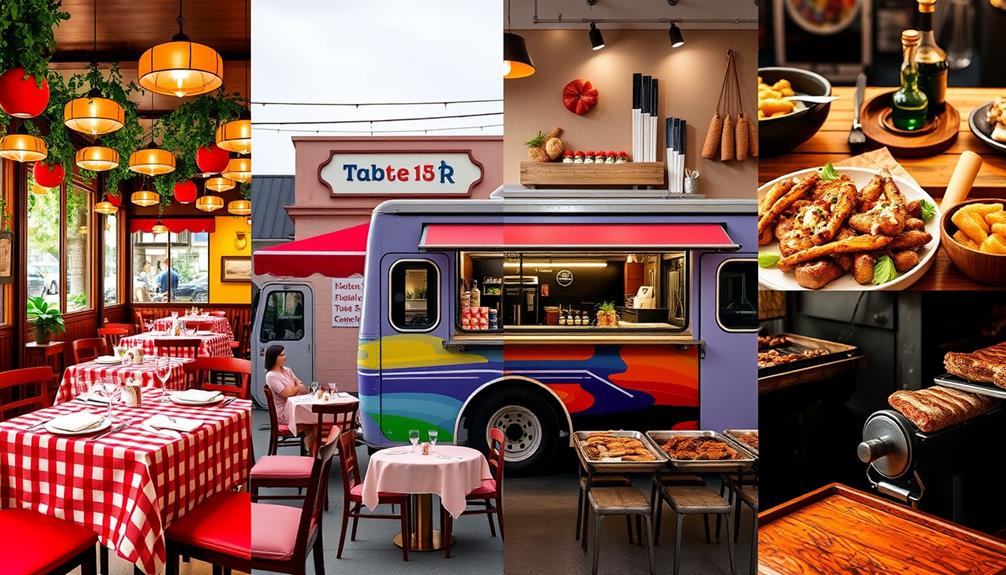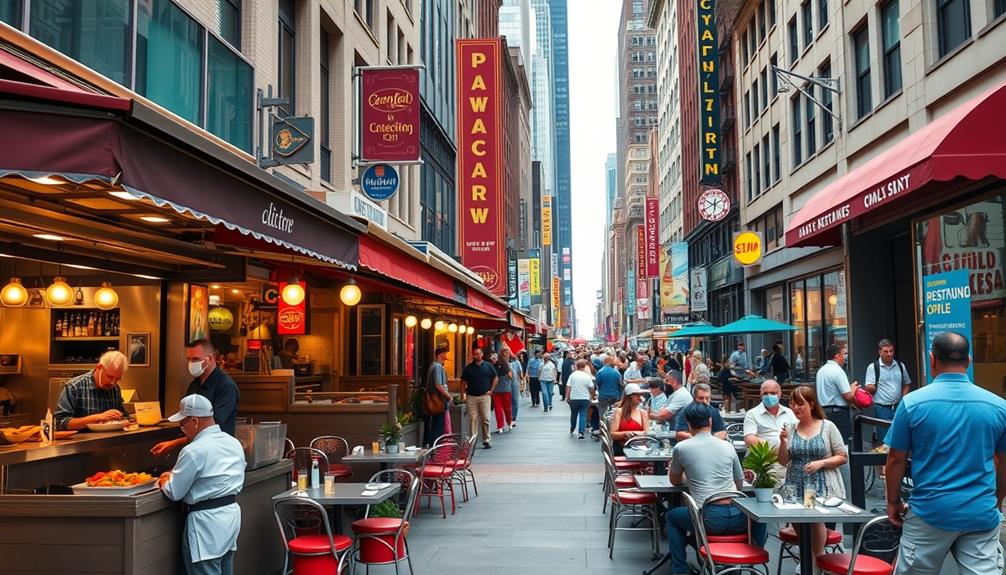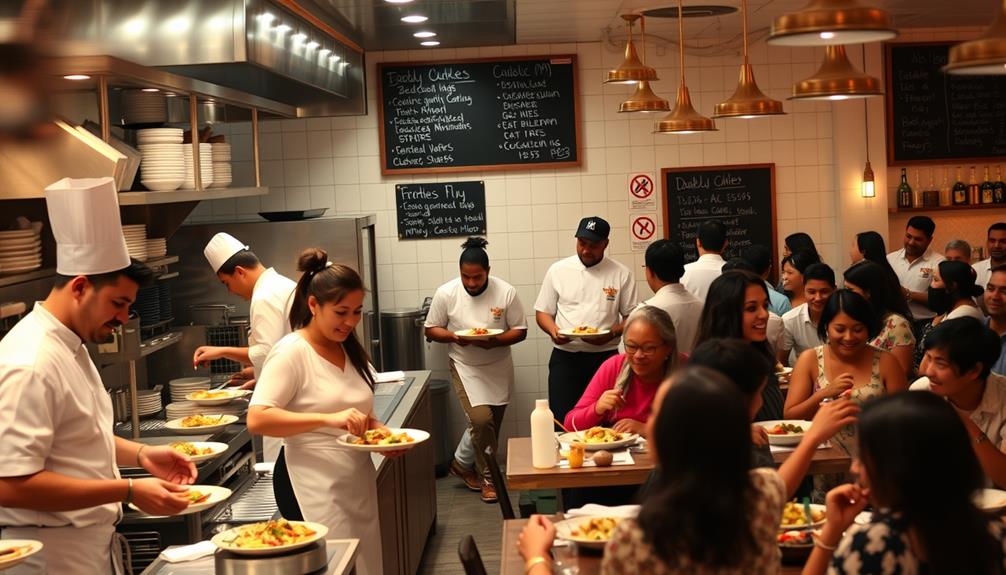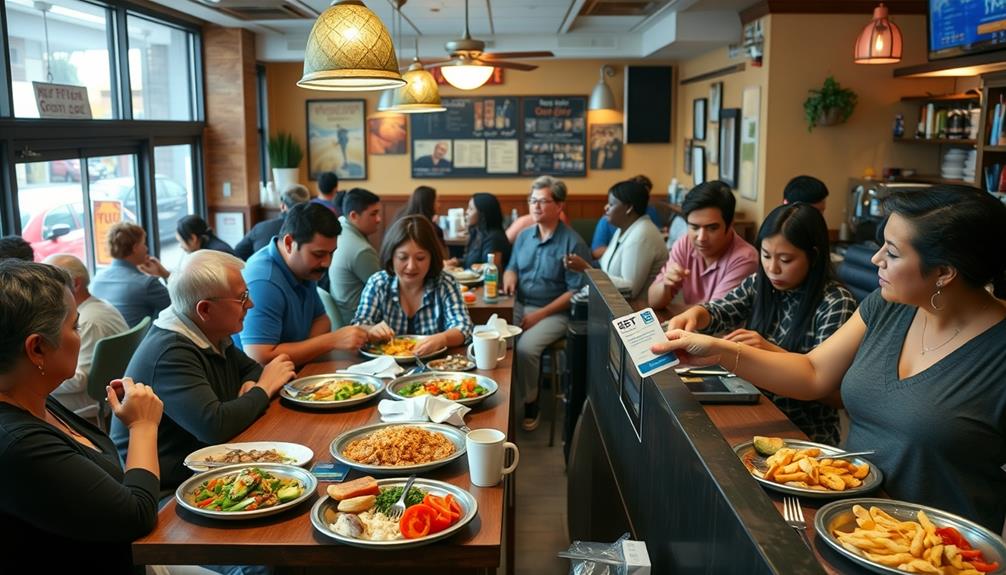As of 2023, you'll find approximately 749,404 restaurants operating across the United States. This impressive number includes around 349,000 chain establishments, which offer recognizable menus, and about 400,000 independent restaurants that provide unique dining experiences. The industry contributes roughly $899 billion in sales and employs about 15.6 million people, making it the second-largest private-sector employer. With dining trends evolving, more people are opting for takeout and delivery. If you're curious about how these numbers influence dining experiences or employment opportunities, there's plenty more to explore about the dynamic restaurant landscape in the U.S.
Key Takeaways
- As of 2023, there are approximately 749,404 restaurants operating in the U.S.
- The count reflects a significant decline from over 1 million restaurants pre-COVID-19.
- About 70% of the total restaurants are classified as independent operations.
- The remaining 349,000 restaurants are categorized as chain businesses.
- The industry is showing resilience through adaptation and innovation despite recent challenges.
Current Restaurant Count

As of 2023, there are roughly 749,404 restaurants operating in the United States. This current restaurant count reflects a significant decline from over 1 million before the Coronavirus pandemic, showcasing the harsh realities the industry faced.
The National Restaurant Association provides essential statistics that help you understand the shifting U.S. restaurant landscape, and you'll find that about 70% of the existing restaurants are independent operations. To navigate this challenging environment, many restaurateurs are implementing goal tracking strategies to enhance their business resilience.
These independent restaurants represent the heart and soul of local dining experiences, while around 349,000 are chain restaurant businesses. Despite the challenges, both types of establishments continue to adapt and innovate to attract customers.
The impact of the pandemic forced many to close their doors permanently, yet the resilience of the industry remains evident. As you explore the current restaurant count, keep in mind the importance of supporting these businesses, whether they're small, independently owned spots or larger chains.
The statistics reveal not just numbers but stories of survival and community connection. Understanding this landscape helps you appreciate the diverse dining options available and the ongoing efforts of restaurateurs to thrive in a post-pandemic world.
Types of Restaurants

The U.S. restaurant scene is incredibly diverse, showcasing a variety of dining options that cater to different tastes and preferences.
You'll find approximately 749,404 restaurants in the United States, split between chain and independent establishments. Chain restaurants make up about 349,000 of this total, offering familiar menus and experiences across multiple locations. The integration of holistic SEO practices can enhance visibility for these establishments, allowing them to reach a broader audience.
However, independent restaurants, with around 156,715 establishments, add a unique flavor to the dining landscape. These full-service restaurants can range from charming local diners to upscale eateries, providing a wide array of culinary experiences.
Fast food restaurants dominate the market, emphasizing quick service and convenience, often appealing to those seeking a fast meal.
Additionally, the restaurant franchise industry continues to grow, driving the popularity of various dining concepts. Trends like food delivery and specialty formats, such as food halls and ghost kitchens, are transforming the types of restaurants available.
This evolution reflects diners' changing preferences, ensuring that there's something for everyone, whether you're grabbing a quick burger or savoring a multi-course meal.
Economic Contribution

Restaurants play a significant role in the U.S. economy, contributing approximately $899 billion in sales in 2023, which accounts for about 4% of the nation's GDP. The impact of the restaurant industry extends beyond just numbers; it creates important connections within local economies and provides numerous job opportunities.
Furthermore, the restaurant sector often collaborates with local farmers and suppliers, enhancing the sustainability of the food system and promoting local agriculture, which is an essential aspect of the economic indicators that influence the overall economic landscape.
- The restaurant sector employs around 15.6 million people, making it the second-largest private-sector employer.
- In 2022, Americans spent a staggering $1.34 trillion on dining out, showcasing a significant shift toward enjoying meals away from home.
- The industry supports various related sectors, such as agriculture and hospitality, amplifying its economic contribution.
Despite facing challenges, like the drastic sales drop to $564.8 billion in 2020 due to the pandemic, the restaurant industry has demonstrated resilience in its recovery efforts.
Consumer Dining Trends

Dining habits in the U.S. are shifting dramatically, with more people opting for meals outside their homes than ever before. In 2022, a striking 56% of food expenses were dedicated to dining out, reflecting a growing trend away from home cooking.
You might notice that approximately 60% of consumers order takeout or delivery services weekly, showcasing a strong preference for convenience in their dining behavior. This trend is similar to the importance of budget management in ensuring financial health while enjoying dining experiences.
Many Americans are willing to spend, with 34% averaging $50 on online food orders. In fact, 56% of surveyed individuals dine out 2-3 times a week, and 10% even indulge 4-6 times. This shift in consumer preferences highlights how dining out has become a regular part of life for many.
Additionally, eco-friendly packaging is increasingly influencing your choices, as 37% of diners consider this when selecting meals.
As you navigate these dining trends, it's clear that the restaurant industry is adapting to your needs, offering more convenient options and sustainable practices. This evolution not only reflects changing tastes but also reshapes the landscape of food expenses and dining experiences across the nation.
Employment in the Industry

With the growing trend of dining out, the restaurant industry has become an essential source of employment for millions of Americans. As of 2023, approximately 15.6 million workers are employed in restaurants, making it the second-largest private-sector employer in the U.S.
Employment in the foodservice industry rebounded to pre-pandemic levels by November 2023, adding over 6 million jobs since the layoffs in April 2020. This sector also emphasizes skill development, as many positions offer pathways to advancement, akin to strategies to navigate partner shutdown, which can enhance teamwork and collaboration among staff.
- 90% of restaurant managers started in entry-level positions, emphasizing the industry's role in workforce development.
- The median hourly wage for waitstaff at full-service restaurants is $27, with upper quartile earners making $41.50 per hour.
- Job openings in the restaurant sector decreased from 8.2% in 2022 to 6.7% by August 2023, indicating a shift in labor demand.
The restaurant industry not only offers various employment opportunities but also fosters career growth. By understanding labor statistics and the dynamics of job openings, you can better navigate your career path in this vibrant sector.
Whether you're aiming to be a restaurant manager or working in a front-line role, the possibilities are endless.
Future Industry Outlook

As you look ahead, the U.S. restaurant industry is set for steady growth, projected to hit $899 billion in sales this year.
You'll notice emerging trends like the rise of fast-casual dining and a strong demand for takeout and delivery options.
Additionally, the integration of technology and online platforms is reshaping customer experiences and operational efficiencies, highlighting the importance of free crypto opportunities for businesses.
However, challenges remain, and understanding these dynamics will be key to steering the future landscape.
Growth Projections
The U.S. restaurant industry is poised for a robust future, projected to reach $899 billion in sales by 2023. This reflects a significant recovery and an upward trajectory post-pandemic. With an annual growth rate of 3% expected over the next five years, you'll witness a steady increase in restaurant establishments and consumer spending.
As families seek out unique experiences, the popularity of venues like hotels with water parks is on the rise, offering dining options that cater to diverse tastes and preferences, including family-friendly amenities.
- The fast-casual segment is set to grow at an impressive 10% annually.
- The online food delivery market, currently valued at $26 billion, underlines the demand for convenience in dining.
- About 60% of adults now prefer takeout or delivery options, shifting consumer preferences.
As the industry statistics indicate, the restaurant sector is adapting to these changes, driving innovation in concepts and offerings. The rise of takeout options and a focus on convenience will influence how restaurants operate and what they provide.
With the fast-casual segment leading the charge, you can expect a more diverse and accessible dining landscape in the coming years. Keeping an eye on these growth projections will help you understand where the restaurant industry is heading and what to look forward to.
Emerging Trends
What new trends are shaping the future of the restaurant industry?
You're witnessing a remarkable shift towards fast-casual restaurants, which are projected to grow at an astonishing 10% annually. This growth reflects changing consumer preferences that favor more casual and flexible dining options.
Additionally, understanding the importance of credit card insights can help restaurants enhance their payment processing systems. The online food delivery market is also booming, currently valued at $26 billion, as restaurants adapt to the increasing reliance on delivery services.
Post-pandemic, around 60% of adults now prefer takeout and delivery, emphasizing the demand for convenience in dining experiences.
As you navigate this evolving landscape, it's crucial to recognize the rising interest in eco-friendly practices. About 30% of diners are willing to spend more on sustainable restaurant practices, making sustainability a pivotal factor in future dining choices.
With the restaurant industry projected to see a steady 3% annual growth over the next five years, it's clear that these emerging trends—fast-casual dining, online food delivery, and sustainability—are key drivers of industry growth.
Challenges Ahead
Maneuvering the restaurant industry in the coming years won't be easy, as several challenges are on the horizon. With rising food costs and fierce competition, it's essential to stay informed and prepared. Furthermore, the need to adapt to changing consumer preferences, such as the increasing demand for cold medications overview and dining experiences, will be critical for success.
- Ongoing labor shortages affecting industry employment
- Increased reliance on delivery apps and ghost kitchens
- Potential decline in consumer spending due to economic pressures
The restaurant industry in the U.S. is projected to grow at a steady rate of 3% annually, but the fast-casual segment is expected to soar at 10%. However, this growth comes with hurdles.
Labor shortages may hinder service quality and limit operational hours, putting you at a disadvantage against competitors. Additionally, supply chain disruptions are driving up food costs, squeezing profit margins.
As inflationary pressures weigh on consumers, discretionary spending may drop, impacting your sales. Furthermore, the rise of delivery apps is changing how diners choose where to eat, forcing traditional establishments to adapt or risk losing foot traffic.
To thrive, you'll need to innovate and find ways to enhance your offerings, ensuring you stand out in a crowded marketplace.
Frequently Asked Questions
How Many Independently Owned Restaurants Are There in the US?
You'll find around 156,715 independently owned full-service restaurants in the U.S. These unique dining spots thrive, offering local flavors and experiences that keep communities vibrant despite challenges from larger chains and economic shifts. In contrast, fast food restaurant data shows that there are over 200,000 fast food establishments in the U.S., with many being part of well-known national chains. However, the appeal of the independent full-service restaurants lies in their ability to offer a more personalized and authentic dining experience, often using locally sourced ingredients and showcasing regional culinary traditions. These establishments play a significant role in shaping the culinary landscape of the country and providing a sense of community and connection for diners.
How Many Single Location Restaurants Are There in the US?
You'll find about 156,715 single-location full-service restaurants in the U.S. These small businesses shape local dining experiences and reflect changing consumer preferences, especially after the significant impacts of the COVID-19 pandemic. These restaurants often rely on loyal customers and positive word-of-mouth to thrive, making them an integral part of their communities. However, they face challenges such as maintaining competitive pricing and navigating restaurant tipping policies to ensure fair compensation for their staff. As they adapt to evolving trends and economic pressures, these small restaurants play a vital role in preserving the diversity and character of America’s dining landscape.
How Many 5 Star Restaurants Are There in US?
Traversing the culinary landscape, you'll find that around 1,000 restaurants boast Michelin stars, with roughly 100 achieving three stars. Other systems, like Zagat, also spotlight five-star gems, enriching your dining journey.
How Many Diners Are There in the USA?
You might be surprised to know there are thousands of diners across the U.S. They're popular for their casual atmosphere, comfort food, and late-night hours, making them a favorite for many seeking a quick meal.
Conclusion
In conclusion, the staggering number of restaurants in the U.S. showcases a vibrant variety of culinary choices. As consumer cravings continue to evolve, the industry adapts to meet demands, driving dynamic developments. With significant economic contributions and countless career opportunities, the future looks bright for this bustling sector. So, whether you're a foodie or a future restaurateur, there's never been a better time to plunge into the delicious world of dining out!









